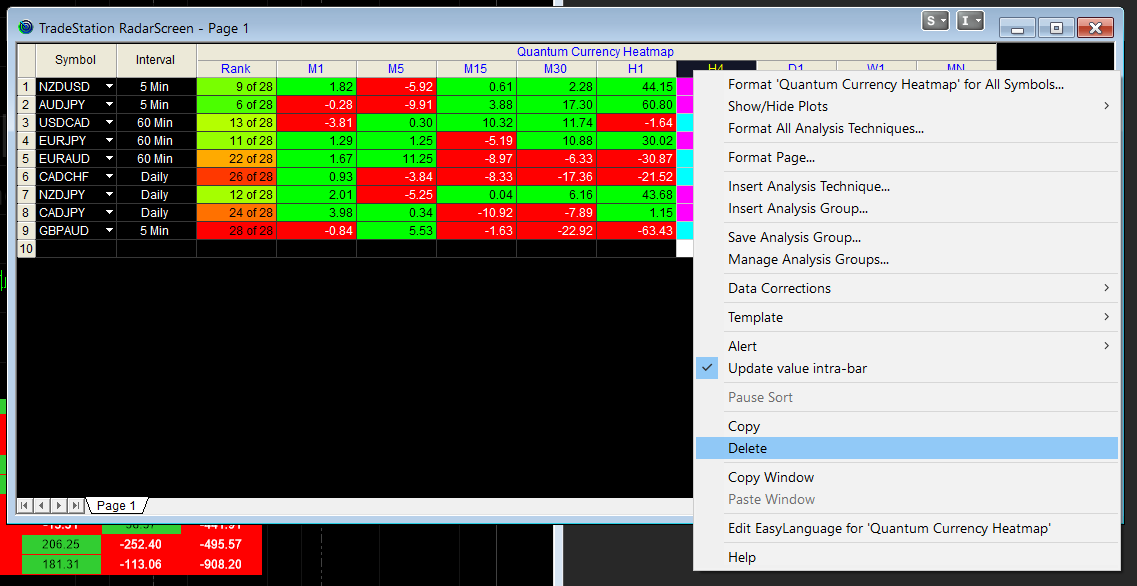Overview
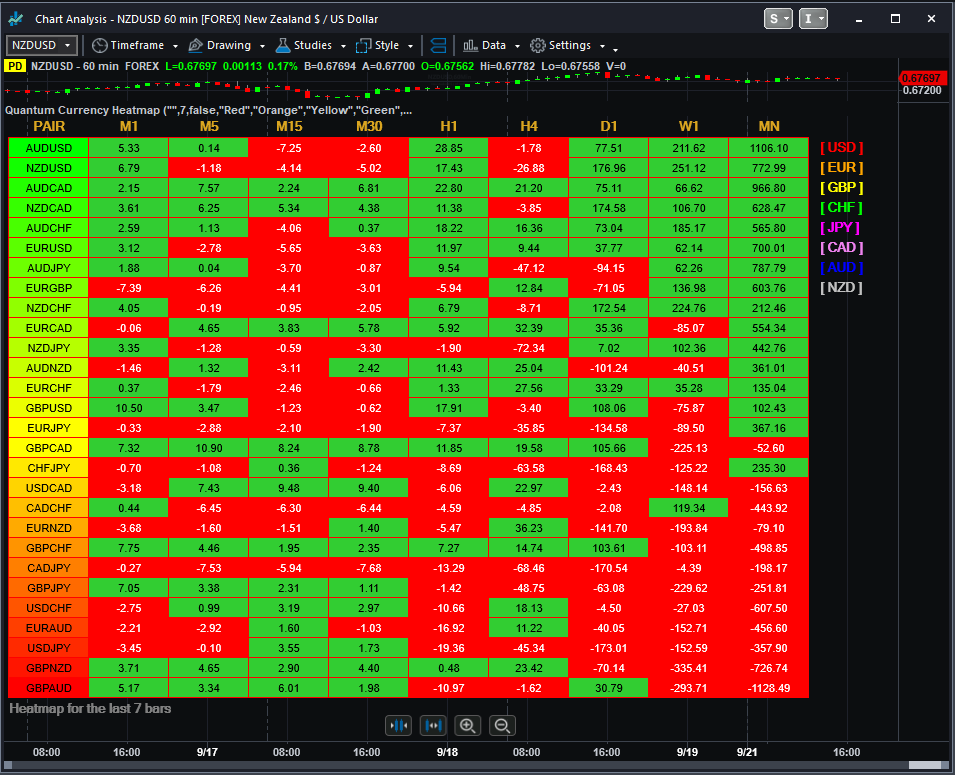
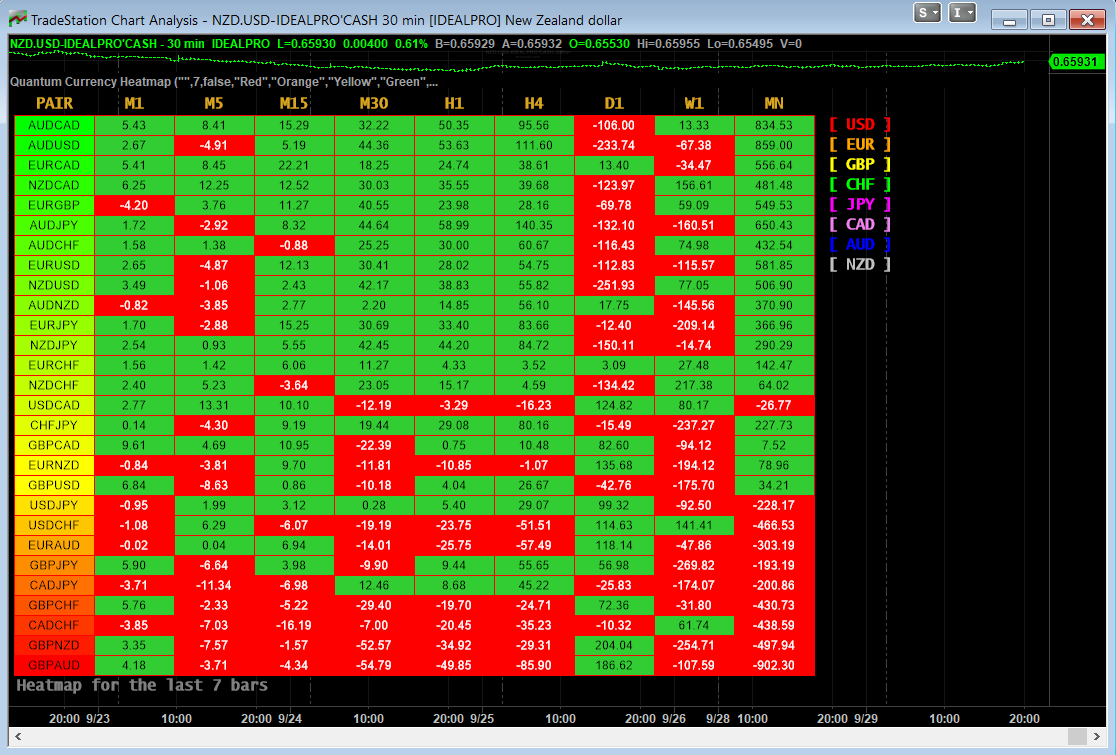
Trading the currency markets is a complex business. With so many pairs and multiple timeframes it is almost impossible to monitor them all – but with with the Currency Heatmap you can. The Currency Heatmap indicator delivers the information you need to base your trading decisions on the entire spectrum of currency pairs derived from the 8 major currencies; namely the US dollar, the Euro, the British Pound, the Swiss Franc, the Japanese Yen, the Canadian Dollar, the Australian Dollar and finally the New Zealand Dollar. In one clear and simple table, you can see instantly the entire weight of market sentiment across all 28 pairs and across all timeframes. A global view of risk and sentiment on one chart.
It instantly displays the “hottest” and “coldest” areas of the financial landscape. Vertically, 28 currency pairs are listed and ranked from the most bullish (top) to the most bearish pair (bottom) and reflect the data ranking on the associated currency matrix indicator. And this is where it gets interesting: horizontally, the performance scores of each currency pair are displayed in 9 timeframes namely 1 minute, 5 minutes, 15 minutes, 30 minutes, hourly, 4 hours, daily, weekly and monthly.
Interpreting the colors
Each cell of the Currency Heatmap indicator is color coded making it possible to interpret it instantly with just a glance, much like looking at a sophisticated thermal imagery scanner, but for Forex. If you check out the indicator, you’ll see how easy and intuitive it is, but let’s just expand on them here.
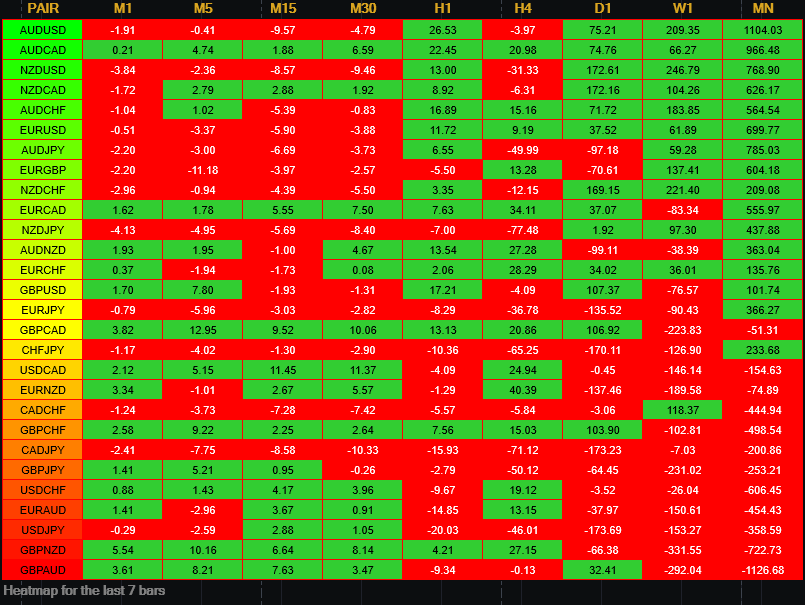
If we start with the performance scores. This is the value the indicator assigns to each currency pair representing how positively or negatively its price moved over a certain period. If you have the Currency Matrix indicator, you’ll also notice that the figures are exactly the same. This is because both use the same algorithm in calculating the performance scores. The cells can be any of the two colors depending on the performance score. This is the color coding used when viewing the currency pairs ACROSS the 9 timeframes or what we like to call the time horizon:
- Green – if the currency pair’s performance score for the aligned timeframe is POSITIVE.
- Red – if the currency pair’s performance score for the aligned timeframe is NEGATIVE.
However, the pairs are then ranked VERTICALLY using a dynamic graded color code transitioning from green, to yellow, and to red in that order. The performance scores of the currency pairs in 9 timeframes are added together. The currency pairs are then ranked by their sum from the most positive to the most negative and are color coded as follows:
- Green shades – the sum of the currency pair’s performance scores in 9 timeframes is well above the fulcrum of zero.
- Yellow shades – the sum of the currency pair’s performance scores in 9 timeframes is relatively flat and around the fulcrum of 0. It can either be positive or negative but trails the numbers closest to 0.
- Red shades – the sum of the currency pair’s performance scores in 9 timeframes is well below the fulcrum of zero.

The gradation of color is dynamic and hence the transition of colors will depend entirely on the sum of the currency pair’s performance scores in 9 timeframes as explained above. As with all our other indicators, this is dynamic and is constantly shifting in real time to reflect the ebb and flow of sentiment across the timeframes.
Weight of the timeframes
One important factor to consider when interpreting the Currency Heatmap indicator and the ranking aspect, is the fact that the performance scores in each timeframe inherently possess weight, and this is reflected in how the indicator has been developed. As you can appreciate, the weight of sentiment in a slower timeframe is greater than that in a faster timeframe. Simply put, the weight of each timeframe is directly proportional to the timeframe itself. Faster timeframes carry less weighting to the overall ranking, whilst slower timeframes carry more. This means currency pairs ranking near or at the bottom of the ladder (bearish) are most likely to have red cells through the slower timeframes or the columns at the right hand side of the indicator. Similarly, the currency pairs at the top and ranking as bullish or very bullish, again are most likely to have green cells through the slower timeframes.

Stepping back, the changing colors deliver a heatmap reflecting the relative performance of the 28 currency pairs across ALL timeframes in real time. This gives a horizontal analysis of the currency pairs across time. Immensely powerful. And empowering you as a trader to make clear, logical and fast decisions.
Currency filter
The Currency Heatmap indicator allows you to filter the currency pairs relevant to the currency you are analysing. Just like the Quantum Currency Matrix indicator, a set of toggle buttons is provided beside the ranking table which you can click to select a currency:
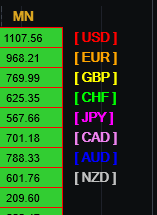
- USD is the red button that selects all currency pairs that contain the US Dollar.
- EUR is the orange button that selects all currency pairs that contain the Euro.
- GBP is the yellow button that selects all currency pairs that contain the British Pound.
- CHF is the green button that selects all currency pairs that contain the Swiss Franc.
- JPY is the magenta button that selects all currency pairs that contain the Japanese Yen.
- CAD is the purple button that selects all currency pairs that contain the Canadian Dollar.
- AUD is the blue button that selects all currency pairs that contain the Australian Dollar.
- NZD is the white button that selects all currency pairs that contain the New Zealand Dollar.
The buttons work on a toggle basis. Click them once to filter, and then click again to remove the filter. When a currency filter is in effect, the relevant currency pairs in the table appear in color while the others turn white.
Getting started
Here are some further details on the currency heatmap indicator to help you get started:
- Your Quantum Currency Heatmap indicator can be applied to any chart for any currency pair. The chart does not influence or affect the appearance or performance of the indicator. For example, you can apply the indicator to a EURUSD, a GBPUSD, or a USDCHF, or any other pair. The indicator will display in an identical way on each chart AND each timeframe.
- The indicator occupies the chart panel itself. We recommend expanding the chart until you get a complete view of the indicator.
- When you first apply the indicator, please allow a few seconds for the data to build in history.
Currency Dashboard
By itself, the Quantum Currency Heatmap indicator is a powerful trading tool for identifying trading opportunities, quickly, easily on a single chart. However, its development is part of a new indicator bundle that we like to call the Quantum Currency Dashboard which consists of the following indicators:
- Quantum Currency Strength Indicator (CSI)
- Quantum Currency Matrix
- Quantum Currency Array
- Quantum Currency Heatmap
These four indicators then provide a unique and compact insight into all the various aspects of strength and weakness for both currencies and currency pairs from trend and momentum to overbought and oversold. What is unique is that using four charts you are then able to monitor the myriad combinations of strength, weakness, momentum, congestion and divergence across the entire forex complex at a click of a button. And even more powerfully giving you the confidence to get in and stay in for maximum profits. No more missed opportunities, no more struggling with multiple charts, and no more trader regret whatever your trading style approach.
Using the indicator in TradeStation Securities
Applying the indicator to a Chart Analysis window
From the Apps menu of your TradeStation platform, please open a Chart Analysis window.
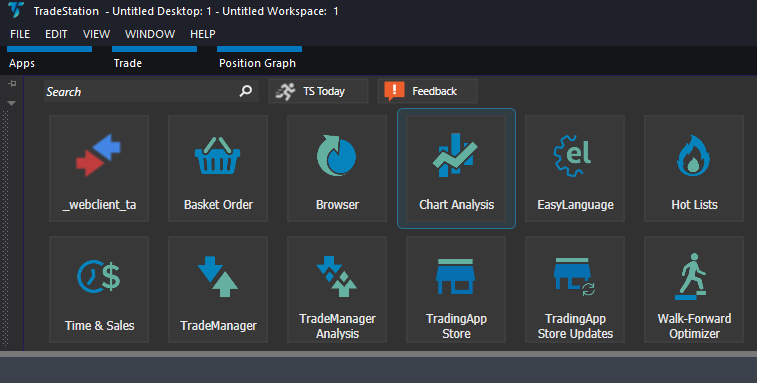
From the Chart Analysis window’s toolbar, please click Studies > Add Study…
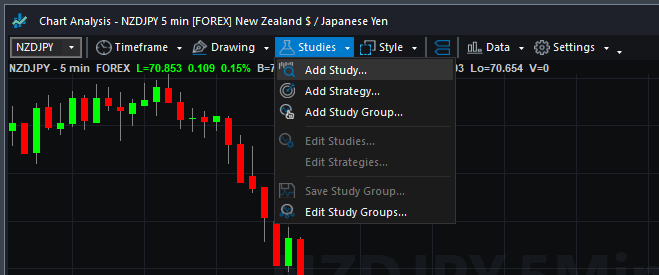
From the Add Study window, please choose Indicator at the left hand side of the interface then at the right, scroll down and select Quantum Currency Heatmap. Click OK to apply the indicator to the chart.
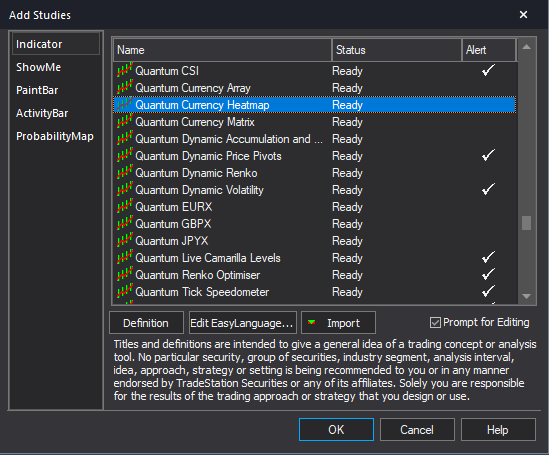
IMPORTANT: If this is your first time to run Quantum Trading indicators, the indicator will not work until you input your email address in its settings. To do this, please go back to your Chart Analysis window and click Studies > Edit Studies…
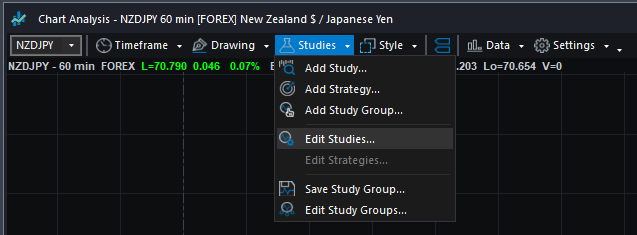
Select the indicator from the list then turn it On by clicking the Status button at the right hand side of the window. Click Customize… or double-click the Quantum Currency Heatmap to open the Customize Indicator window. In the Inputs section, find the MyQuantumTradingEmail input and enter here the email address you used at the Quantum Trading Shop to activate the indicator. PLEASE MAKE SURE TO ENCLOSE THE EMAIL ADDRESS IN DOUBLE QUOTATION MARKS. (example: “myemailaddress@gmail.com”)
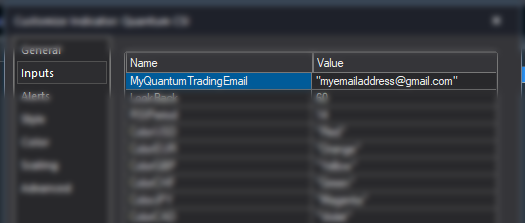
Click OK (and Close) to save and go back to your chart. Please note that you need to do this only once which means you do not need to input your email address again when running Quantum Trading indicators next time.
Customizing the indicator in Chart Analysis
Inputs
- MyQuantumTradingEmail – When running the indicator for the first time in your TradeStation trading account, you need to enter the email address you used to purchase the indicator in the Quantum Trading Shop as part of its verification process. You need to do this only once as the indicators “remember” your email address by storing it in the local drive. Please make sure that you enter your email address correctly and exactly without any extra spaces before and after it. If you made an error, simply fill this input again to update it. This is a string input which requires you to enclose your email address in double quotation marks (“”).
- LookBack – The Currency Heatmap requires a significant amount of processing power compared to most indicators and this input limits it to calculate the last 7 bars by default. The higher the value of this input is, the more processing power is required, although you can change this if you wish to extend its coverage in the bar history. It also helps in keeping the indicator’s output relevant according to the most current price action.
- ClassicColors – Instead of using a Green-Red gradient, the indicator switches to a dual color scheme when this setting is true. When using classic colors, all currency pairs with a score above 0 are blue and those below 0 are red. This is set to false by default.
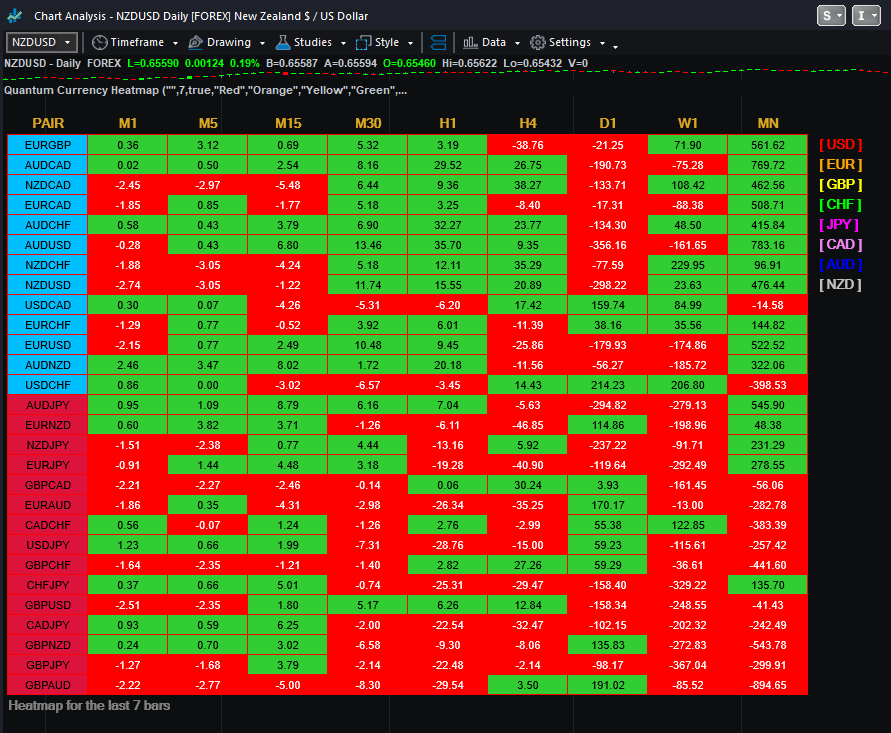
- ButtonColorUSD, ButtonColorEUR, ButtonColorGBP, ButtonColorCHF, ButtonColorJPY, ButtonColorCAD, ButtonColorAUD, ButtonColorNZD – These inputs define the colors of the indicator’s currency buttons. They are string inputs which means you need to enclose the name color in double quotation marks (“”). Named colors are the only accepted values in these inputs which are all listed in the following link – http://help.tradestation.com/09_01/tsdevhelp/Subsystems/elobject/class_win/color_class.htm

The color of a line reverts to the default named color if the input’s value is invalid. - BullishBGColor – This input determines the background color of the cells whose value is on the positive side or of bullish sentiment. This is a string input which means you need to enclose the name color in double quotation marks (“”). Named colors are the only accepted values in these inputs which are all listed in the following link – http://help.tradestation.com/09_01/tsdevhelp/Subsystems/elobject/class_win/color_class.htm
- BullishTextColor – This input determines the text color of the cells whose value is on the positive side or of bullish sentiment. This is a string input which means you need to enclose the name color in double quotation marks (“”). Named colors are the only accepted values in these inputs which are all listed in the following link – http://help.tradestation.com/09_01/tsdevhelp/Subsystems/elobject/class_win/color_class.htm
- BearishBGColor – This input determines the background color of the cells whose value is on the negative side or of bearish sentiment. This is a string input which means you need to enclose the name color in double quotation marks (“”). Named colors are the only accepted values in these inputs which are all listed in the following link – http://help.tradestation.com/09_01/tsdevhelp/Subsystems/elobject/class_win/color_class.htm
- BearishTextColor – This input determines the text color of the cells whose value is on the negative side or of bearish sentiment. This is a string input which means you need to enclose the name color in double quotation marks (“”). Named colors are the only accepted values in these inputs which are all listed in the following link – http://help.tradestation.com/09_01/tsdevhelp/Subsystems/elobject/class_win/color_class.htm
- BookmarkedCurrencyPairs– This input helps you keep track of currency pairs you’re interested in wherever they are in the list. To bookmark a currency pair, simply enter its symbol (without any prefix or suffix) in this field like so:
“eurusd”
You can bookmark multiple currency pairs at the same time by adding a space between them. For example, if you like to bookmark EURUSD, AUDCHF and USDJPY, simply enter the following value in this field:
“eurusd audchf usdjpy”
All bookmarked currency pairs are given a different color so you can see them easily in the constantly changing list. They are also not affected by the currency filters. This is a string input which means you need to enclose the currency pair(s) in double quotation marks (“”).
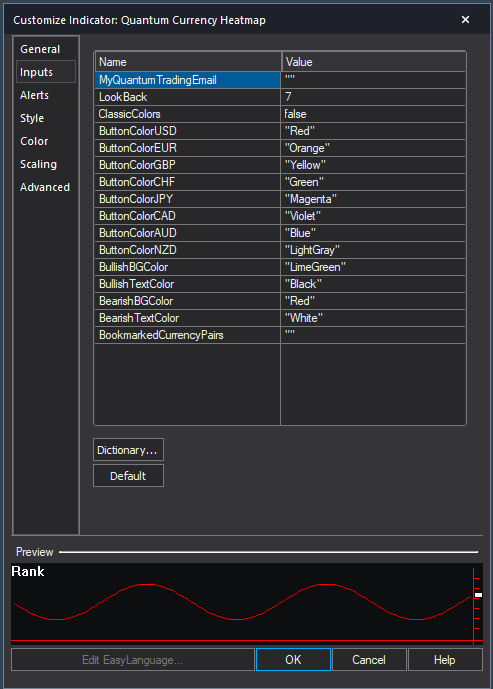
General
You can modify the name, short name, notes, maximum number of bars the indicator will reference, and more. We do not recommend changing any of the settings in this section but you can learn more about the different options in the General tab in TradeStation’s help guide at the link below.
http://help.tradestation.com/10_00/eng/tradestationhelp/study/customize_study_general.htm
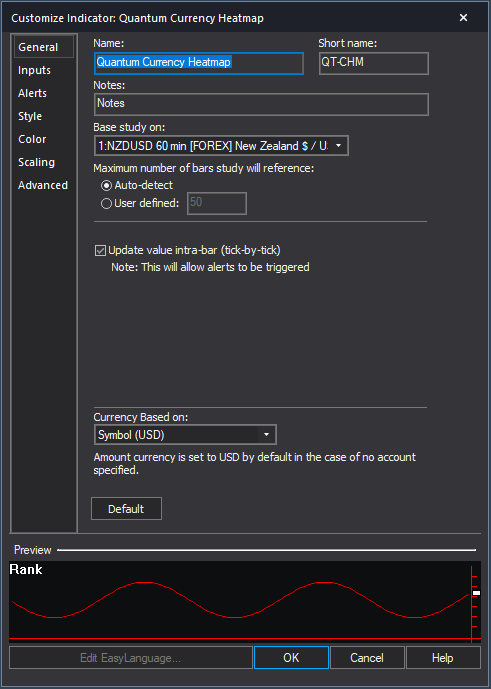
Alerts
The Currency Heatmap does not have built-in alert functions.
You can learn more about the different options in the Alerts tab in TradeStation’s help guide at the link below.
http://help.tradestation.com/10_00/eng/tradestationhelp/study/customize_study_alerts.htm
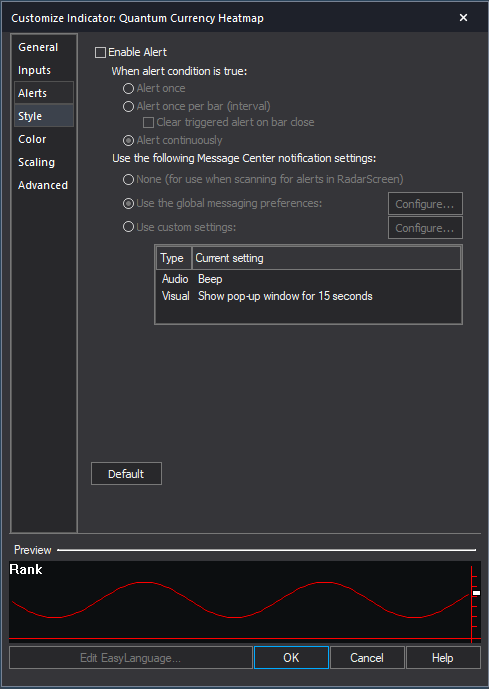
Style
We do not recommend changing the settings in this section as the Currency Heatmap does not plot lines.
You can learn more about the different options in the Style tab in TradeStation’s help guide at the link below.
http://help.tradestation.com/10_00/eng/tradestationhelp/study/customize_study_style.htm
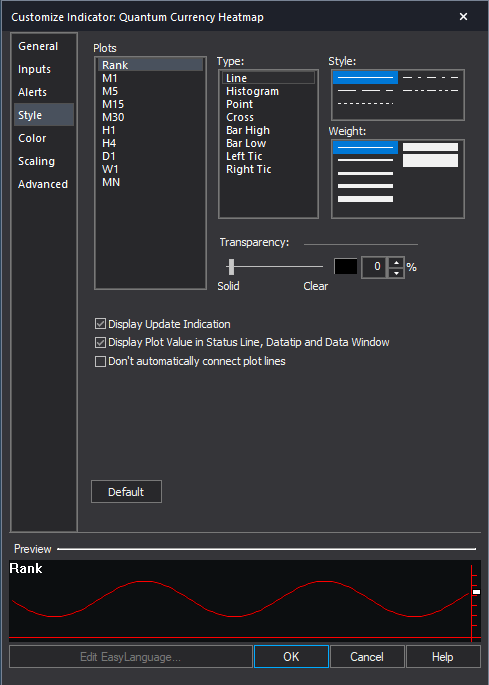
Color
We do not recommend changing the colors of the indicator in this section. Instead, please use the “ButtonColor…” inputs defined in its Inputs to safely change the color of the currency buttons. The cell colors can be customized in the Inputs section as well.
You can learn more about the different options in the Color tab in TradeStation’s help guide at the link below.
http://help.tradestation.com/10_00/eng/tradestationhelp/study/customize_study_color.htm
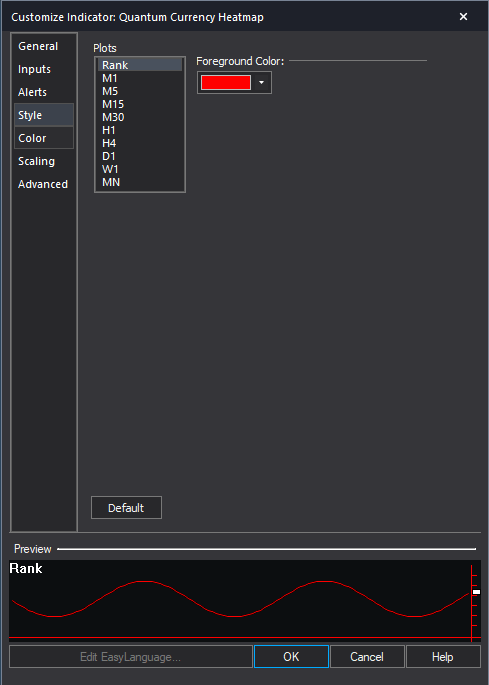
Scaling
The Scaling tab is used to modify the scaling settings for the y-axis of the indicator in the active Chart Analysis window. We do not recommend changing any of the settings in this section but you can learn more about the different options in the Scaling tab in TradeStation’s help guide at the link below.
http://help.tradestation.com/10_00/eng/tradestationhelp/study/customize_study_scaling.htm
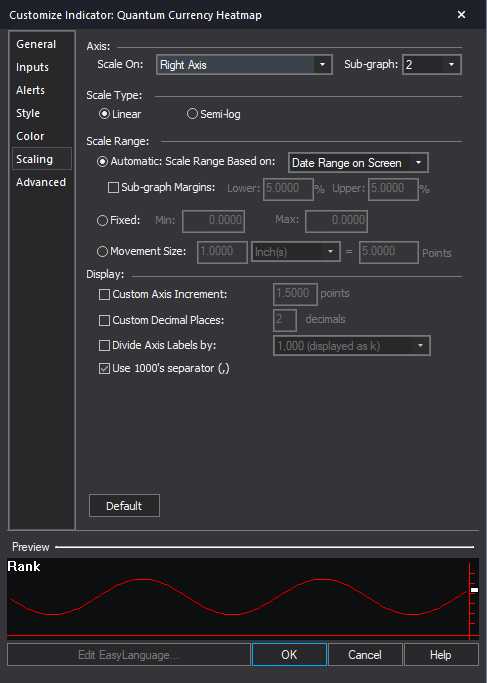
Advanced
The Advanced tab allows you to set advanced preferences for the indicator. We do not recommend changing any of the settings in this section but you can learn more about the different options in the Advanced tab in TradeStation’s help guide at the link below.
http://help.tradestation.com/10_00/eng/tradestationhelp/study/customize_study_advanced.htm
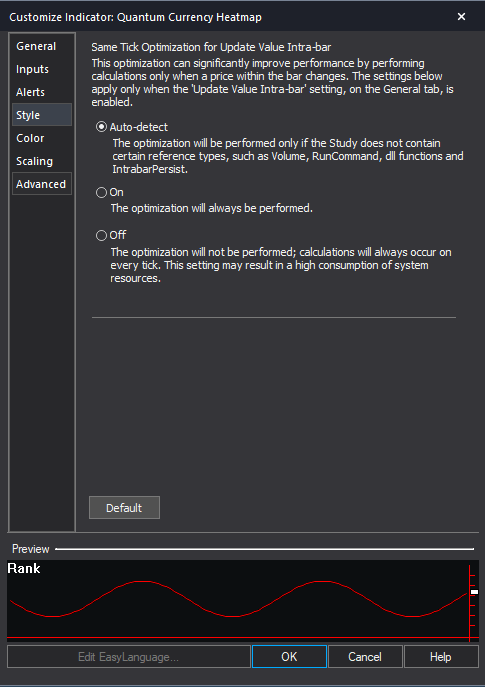
Making adjustments to the user interface in Chart Analysis
Currency Buttons
The currency buttons are the colored text enclosed in square brackets located at the right side of the heatmap. Please note that you need to extend the border of the indicator vertically to reveal the currency buttons. Please see the section below for more details.

Each button represents one of the 8 major currency pairs: USD, EUR, GBP, CHF, JPY, CAD, AUD and NZD. Clicking a button toggles the color of the currency pairs in the heatmap that contain the currency. A button can be one of 2 states: NOT SELECTED or SELECTED. Clicking a button selects it and displays the word “SELECTED” in the button label. Clicking the button again, deselects the button and returns to its normal state.
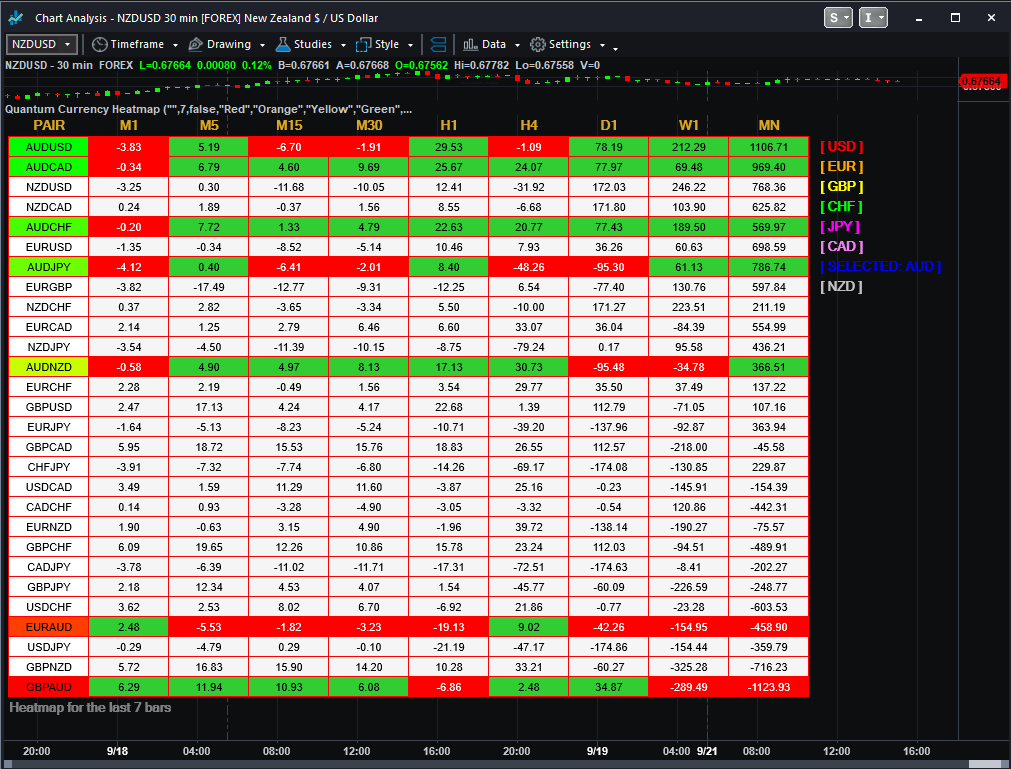
For example: [ AUD ] is not selected while [ SELECTED: AUD ] is selected.
- When a button is selected, all currency pairs in the heatmap that contain the selected currency retain their color while the others turn white.
- Selecting another button deselects the previously selected button as only one currency can be selected at any moment.
- Clicking a selected button deselects it and returns the heatmap to its normal state.
Using the currency buttons, you can easily focus on a currency or group of currencies easily.
Expanding the Indicator’s Screen Size
Follow the steps below to expand the Quantum Currency Heatmap’s screen size in the chart.
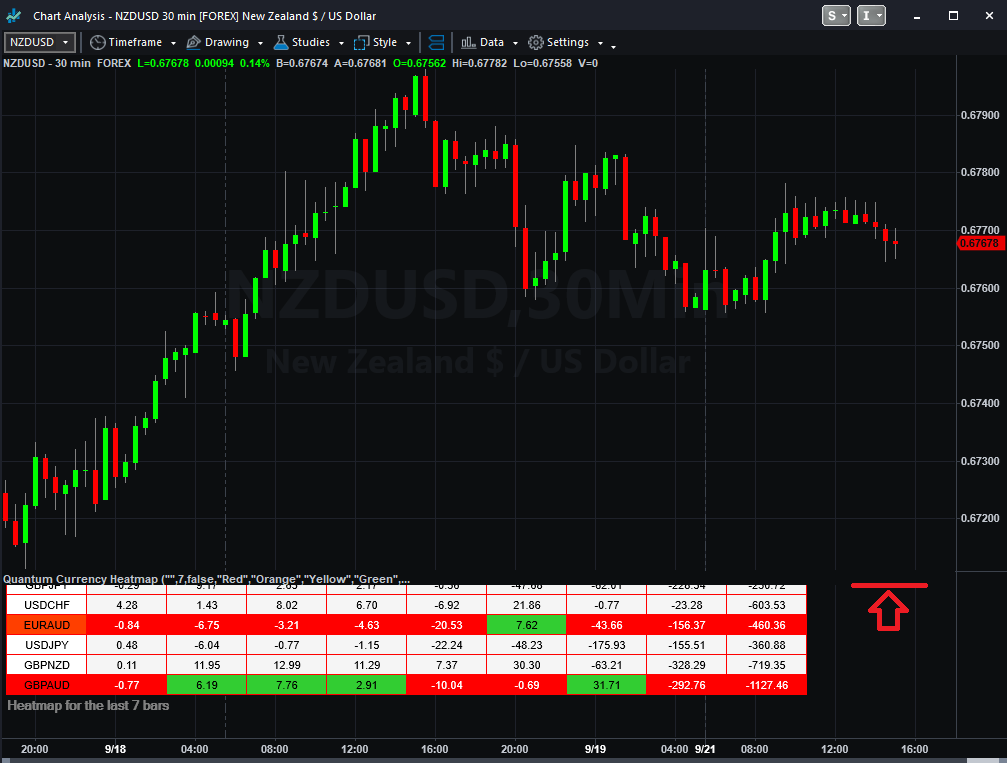
- Hover your mouse pointer over the space between the Quantum Currency Heatmap and the chart above it until the mouse cursor changes into a double headed arrow
- HOLD down the left click on your mouse, and drag the mouse to the top until the entire indicator is visible
- Hover your mouse over the right hand edge of the chart until a double headed arrow appears
- HOLD down the left click on your mouse, and drag the right hand edge of the chart across to the left and release when done
- Click on the chart to make it the active window
- Click on the Increase Spacing – Up Arrow icon below, to expand your indicator to full size. The Increase Spacing – Up Arrow button is shown below when you hover over the bottom portion of the chart window.
Removing the indicator from the Chart Analysis window
From the Chart Analysis window’s toolbar, please click Studies > Edit Studies…
In the Studies tab, select Quantum Currency Heatmap and click Remove then click Close.
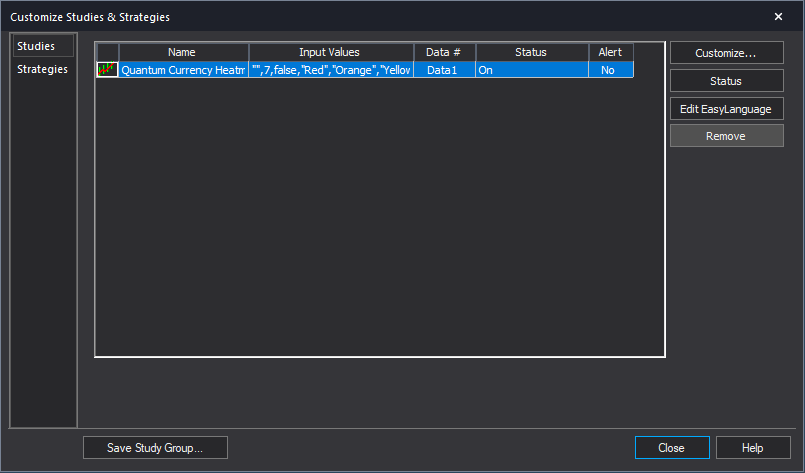
Applying the indicator to RadarScreen
From the Apps menu of your TradeStation platform, please open a RadarScreen window.

From the RadarScreen window’s toolbar, please click Studies > Add Study…
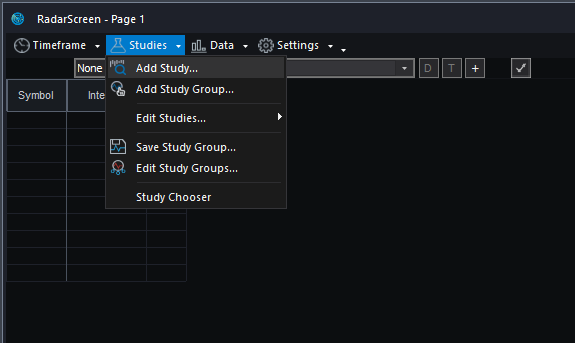
From the Add Study window, please choose Indicator at the left hand side of the interface then at the right, scroll down and select Quantum Currency Heatmap. Click OK to apply the indicator to the chart.
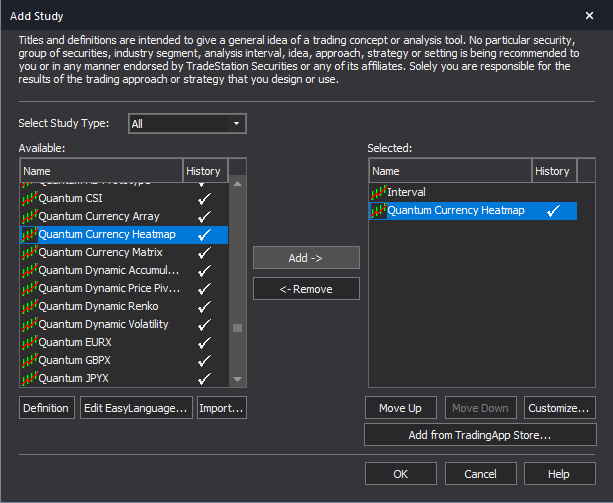
IMPORTANT: If this is your first time to run Quantum Trading indicators, the indicator will not work until you input your email address in its settings. To do this, please go back to your RadarScreen window and click Studies > Edit Studies… > All Studies…
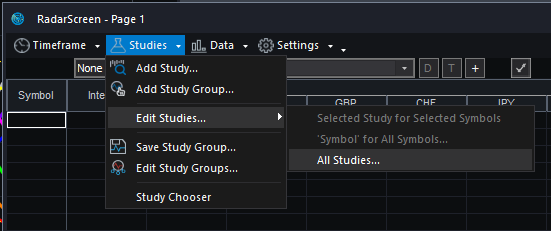
Double-click the Quantum Currency Heatmap to open the Customize Indicator window. In the Inputs section, find the MyQuantumTradingEmail input and enter here the email address you used at the Quantum Trading Shop to activate the indicator. PLEASE MAKE SURE TO ENCLOSE THE EMAIL ADDRESS IN DOUBLE QUOTATION MARKS. (example: “myemailaddress@gmail.com”)

Click OK (and Close) to save and go back to RadarScreen. Please note that you need to do this only once which means you do not need to input your email address again when running Quantum Trading indicators next time.
Compatible symbols in RadarScreen
The indicator works with currency pairs that belong to the combination of the 8 major currencies which are USD, EUR, GBP, CHF, JPY, CAD, AUD and NZD.
RadarScreen columns
Rank
Displays the rank (top to bottom from bullish to bearish) of the currency pair out of the 28 currency pairs in the row’s Interval (timeframe)
M1
Displays the performance score of the currency pair in the 1-minute timeframe within the LookBack period
M5
Displays the performance score of the currency pair in the 5-minute timeframe within the LookBack period
M15
Displays the performance score of the currency pair in the 15-minute timeframe within the LookBack period
M30
Displays the performance score of the currency pair in the 30-minute timeframe within the LookBack period
H1
Displays the performance score of the currency pair in the hourly timeframe within the LookBack period
H4
Displays the performance score of the currency pair in the 4-hour timeframe within the LookBack period
D1
Displays the performance score of the currency pair in the daily timeframe within the LookBack period
W1
Displays the performance score of the currency pair in the weekly timeframe within the LookBack period
MN
Displays the performance score of the currency pair in the monthly timeframe within the LookBack period

Color changes in the RadarScreen
The cell’s background and text color may change on certain conditions.
Cell background color changes
- Green shades (Rank column) – the currency pair is at the top part of the heatmap’s Rank column (bullish)
- Yellow shades (Rank column) the currency pair is at the middle part of the heatmap
- Red shades (Rank column) – the currency pair is at the bottom part of the heatmap’s Rank column (bearish)
- Green (M1-MN columns) – bullish performance within the given period
- Red (M1-MN columns) – bearish performance within the given period
Removing the indicator from RadarScreen
From the RadarScreen window’s toolbar, please click Studies > Edit Study… > All Studies… then select/click Quantum Currency Heatmap in the list at right hand side of the window. Click the “<- Remove” button then click OK to close the window.
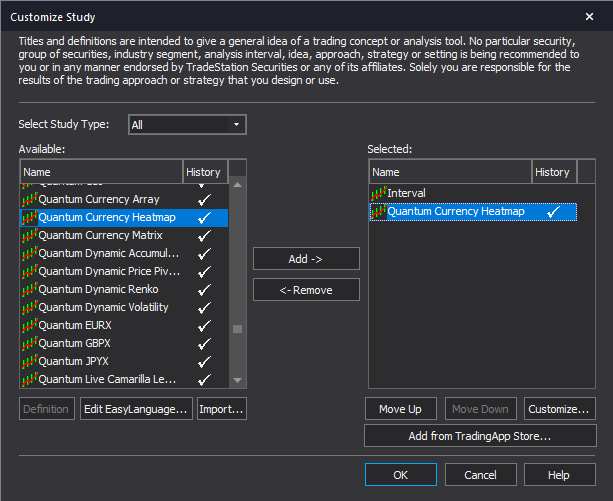
Using the indicator in TradeStation Global
Applying the indicator to a Chart Analysis window
From the Apps menu of your TradeStation platform, please open a Chart Analysis window.
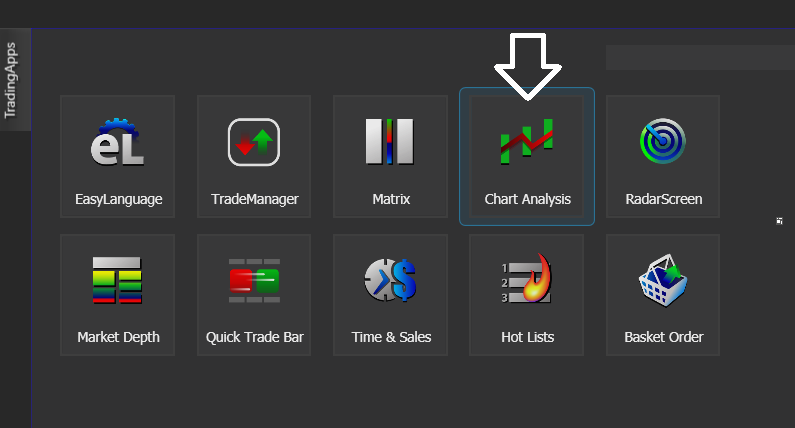
From the menu bar, click Insert > Indicator… > Indicator tab then scroll down at the list and select the Quantum Currency Heatmap and click OK to apply the indicator in the chart.
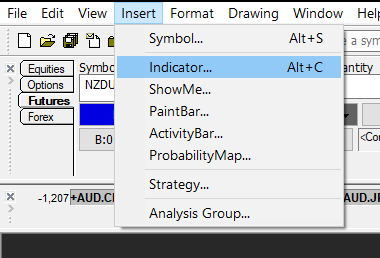
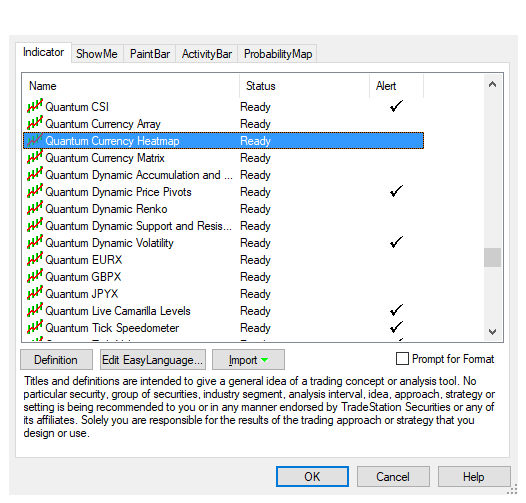
IMPORTANT: If this is your first time to run Quantum Trading indicators, the indicator will not work until you input your email address in its settings. To do this, please go back to your Chart Analysis window then in the menu bar, click Format > Analysis Techniques…
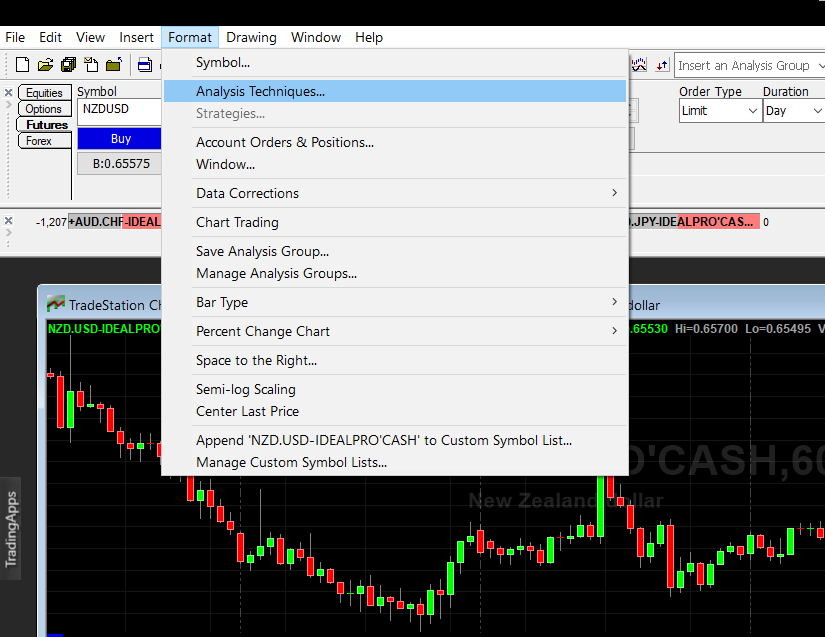
Select the indicator from the list then turn it On by clicking the Status button at the right hand side of the window. Click Format… or double-click the Quantum Currency Heatmap to open the Format Indicator window. In the Inputs section, find the MyQuantumTradingEmail input and enter here the email address you used at the Quantum Trading Shop to activate the indicator. PLEASE MAKE SURE TO ENCLOSE THE EMAIL ADDRESS IN DOUBLE QUOTATION MARKS. (example: “myemailaddress@gmail.com”)
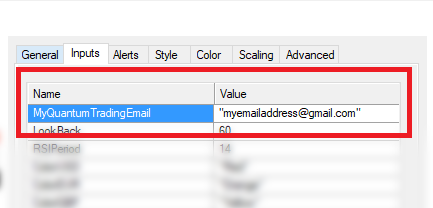
Click OK (and Close) to save and go back to your chart. Please note that you need to do this only once which means you do not need to input your email address again when running Quantum Trading indicators next time.
Customizing the indicator in Chart Analysis
Inputs
- MyQuantumTradingEmail – When running the indicator for the first time in your TradeStation trading account, you need to enter the email address you used to purchase the indicator in the Quantum Trading Shop as part of its verification process. You need to do this only once as the indicators “remember” your email address by storing it in the local drive. Please make sure that you enter your email address correctly and exactly without any extra spaces before and after it. If you made an error, simply fill this input again to update it. This is a string input which requires you to enclose your email address in double quotation marks (“”).
- LookBack – The Currency Heatmap requires a significant amount of processing power compared to most indicators and this input limits it to calculate the last 7 bars by default. The higher the value of this input is, the more processing power is required, although you can change this if you wish to extend its coverage in the bar history. It also helps in keeping the indicator’s output relevant according to the most current price action.
- ClassicColors – Instead of using a Green-Red gradient, the indicator switches to a dual color scheme when this setting is true. When using classic colors, all currency pairs with a score above 0 are blue and those below 0 are red. This is set to false by default.
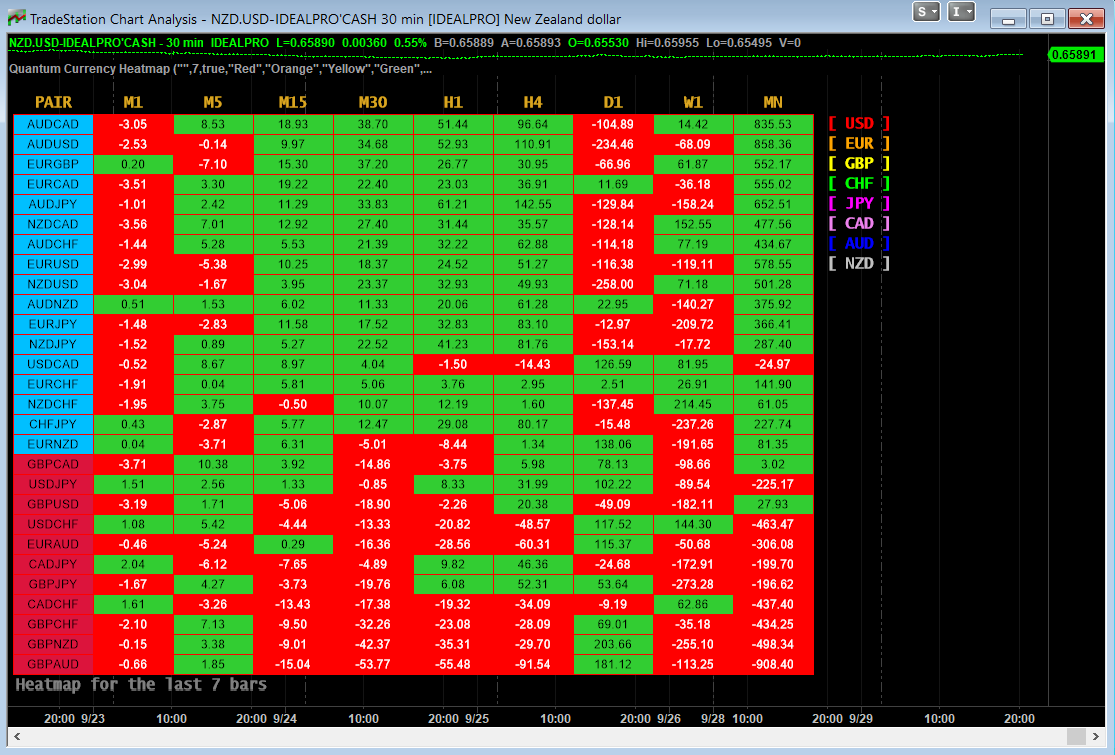
- ButtonColorUSD, ButtonColorEUR, ButtonColorGBP, ButtonColorCHF, ButtonColorJPY, ButtonColorCAD, ButtonColorAUD, ButtonColorNZD – These inputs define the colors of the indicator’s currency buttons. They are string inputs which means you need to enclose the name color in double quotation marks (“”). Named colors are the only accepted values in these inputs which are all listed in the following link – http://help.tradestation.com/09_01/tsdevhelp/Subsystems/elobject/class_win/color_class.htm
The color of a line reverts to the default named color if the input’s value is invalid. - BullishBGColor – This input determines the background color of the cells whose value is on the positive side or of bullish sentiment. This is a string input which means you need to enclose the name color in double quotation marks (“”). Named colors are the only accepted values in these inputs which are all listed in the following link – http://help.tradestation.com/09_01/tsdevhelp/Subsystems/elobject/class_win/color_class.htm
- BullishTextColor – This input determines the text color of the cells whose value is on the positive side or of bullish sentiment. This is a string input which means you need to enclose the name color in double quotation marks (“”). Named colors are the only accepted values in these inputs which are all listed in the following link – http://help.tradestation.com/09_01/tsdevhelp/Subsystems/elobject/class_win/color_class.htm
- BearishBGColor – This input determines the background color of the cells whose value is on the negative side or of bearish sentiment. This is a string input which means you need to enclose the name color in double quotation marks (“”). Named colors are the only accepted values in these inputs which are all listed in the following link – http://help.tradestation.com/09_01/tsdevhelp/Subsystems/elobject/class_win/color_class.htm
- BearishTextColor – This input determines the text color of the cells whose value is on the negative side or of bearish sentiment. This is a string input which means you need to enclose the name color in double quotation marks (“”). Named colors are the only accepted values in these inputs which are all listed in the following link – http://help.tradestation.com/09_01/tsdevhelp/Subsystems/elobject/class_win/color_class.htm
- BookmarkedCurrencyPairs– This input helps you keep track of currency pairs you’re interested in wherever they are in the list. To bookmark a currency pair, simply enter its symbol (without any prefix or suffix) in this field like so:
“eurusd”
You can bookmark multiple currency pairs at the same time by adding a space between them. For example, if you like to bookmark EURUSD, AUDCHF and USDJPY, simply enter the following value in this field:
“eurusd audchf usdjpy”
All bookmarked currency pairs are given a different color so you can see them easily in the constantly changing list. They are also not affected by the currency filters. This is a string input which means you need to enclose the currency pair(s) in double quotation marks (“”).
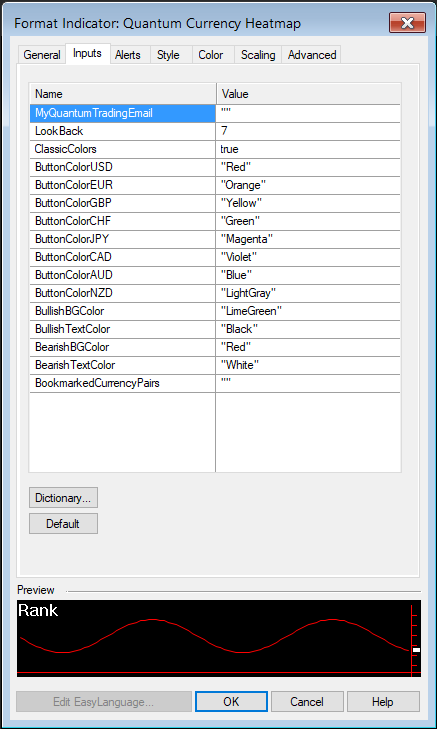
General
You can modify the name, short name, notes, maximum number of bars the indicator will reference, and more. We do not recommend changing any of the settings in this section but you can learn more about the different options in the General tab in TradeStation’s help guide at the link below.
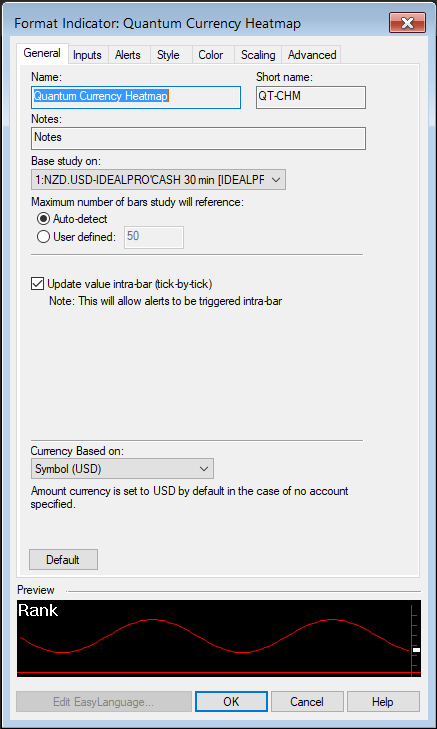
Alerts
The Currency Heatmap does not have built-in alert functions.
You can learn more about the different options in the Alerts tab in TradeStation’s help guide at the link below.
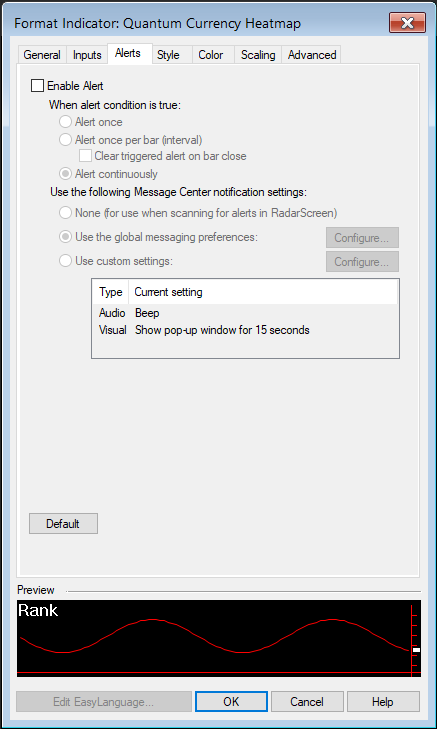
Style
We do not recommend changing the settings in this section as the Currency Heatmap does not plot lines.
You can learn more about the different options in the Style tab in TradeStation’s help guide at the link below.
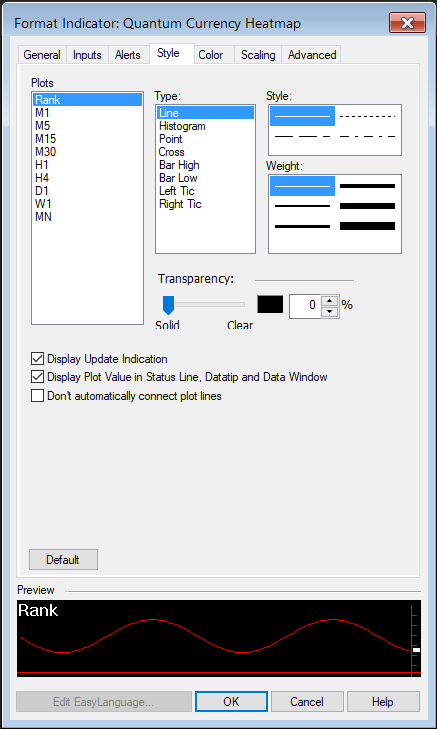
Color
We do not recommend changing the colors of the indicator in this section. Instead, please use the “ButtonColor…” inputs defined in its Inputs to safely change the color of the currency buttons. The cell colors can be customized in the Inputs section as well.
You can learn more about the different options in the Color tab in TradeStation’s help guide at the link below.
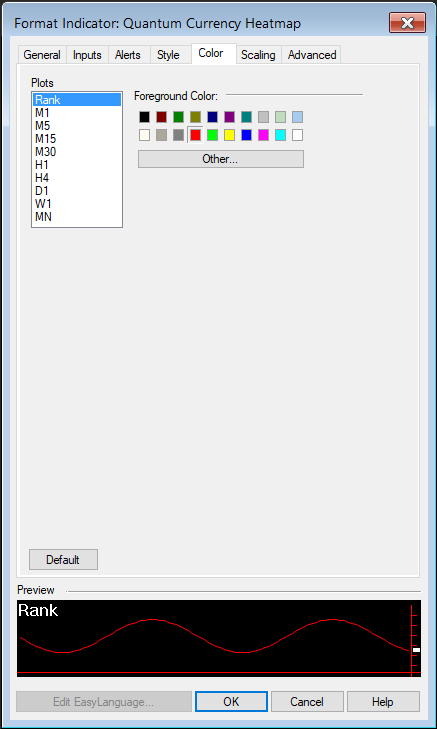
Scaling
The Scaling tab is used to modify the scaling settings for the y-axis of the indicator in the active Chart Analysis window. We do not recommend changing any of the settings in this section but you can learn more about the different options in the Scaling tab in TradeStation’s help guide at the link below.
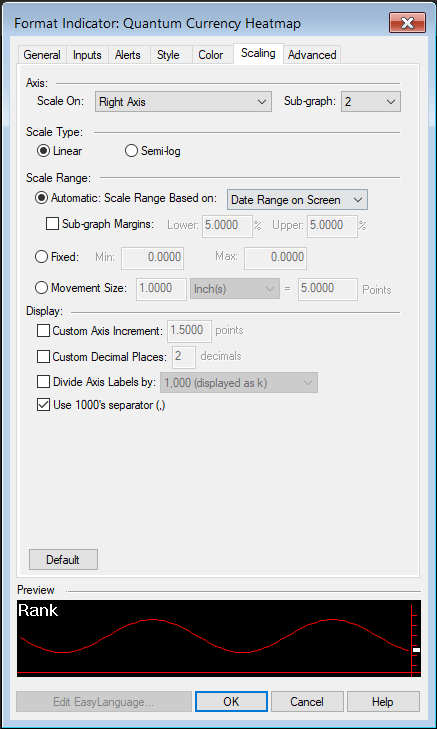
Advanced
The Advanced tab allows you to set advanced preferences for the indicator. We do not recommend changing any of the settings in this section but you can learn more about the different options in the Advanced tab in TradeStation’s help guide at the link below.
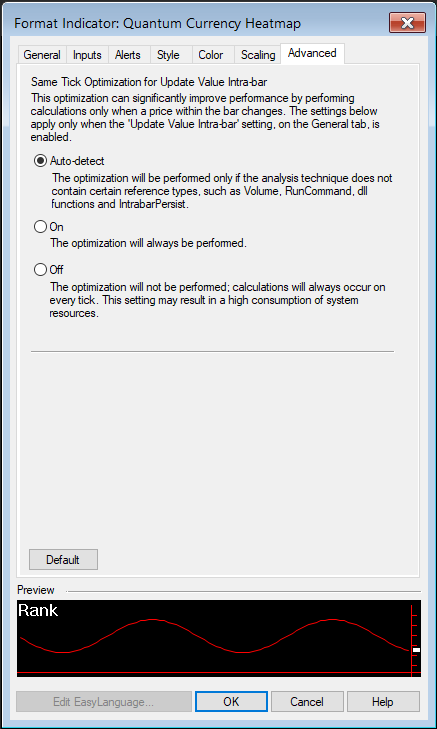
Making adjustments to the user interface in Chart Analysis
Currency Buttons
The currency buttons are the colored text enclosed in square brackets located at the right hand side of the heatmap. Please note that you need to extend the border of the indicator vertically to reveal the currency buttons. Please see the section below for more details.
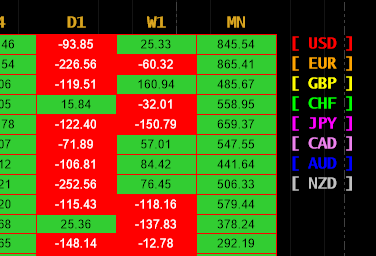
Each button represents one of the 8 major currency pairs: USD, EUR, GBP, CHF, JPY, CAD, AUD and NZD. Clicking a button toggles the visibility of the currency pairs in the heatmap that contain the currency. A button can be one of 2 states: NOT SELECTED or SELECTED. Clicking a button selects it and displays the word “SELECTED” in the button label. Clicking the button again, deselects the button and returns to its normal state.
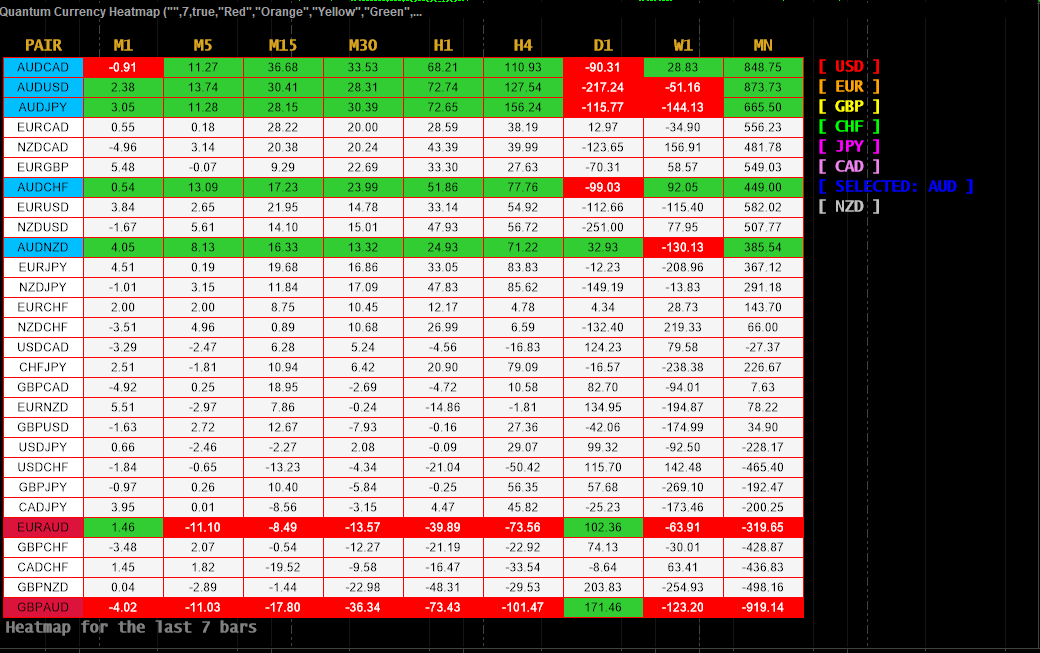
For example: [ AUD ] is not selected while [ SELECTED: AUD ] is selected.
- When a button is selected, all currency pairs in the heatmap that contain the selected currency retain their color while the others turn white.
- Selecting another button deselects the previously selected button as only one currency can be selected at any moment.
- Clicking a selected button deselects it and returns the heatmap to its normal state.
Using the currency buttons, you can easily focus on a currency or group of currencies easily.
Expanding the Indicator’s Screen Size
Follow the steps below to expand the Quantum Currency Heatmap’s screen size in the chart.
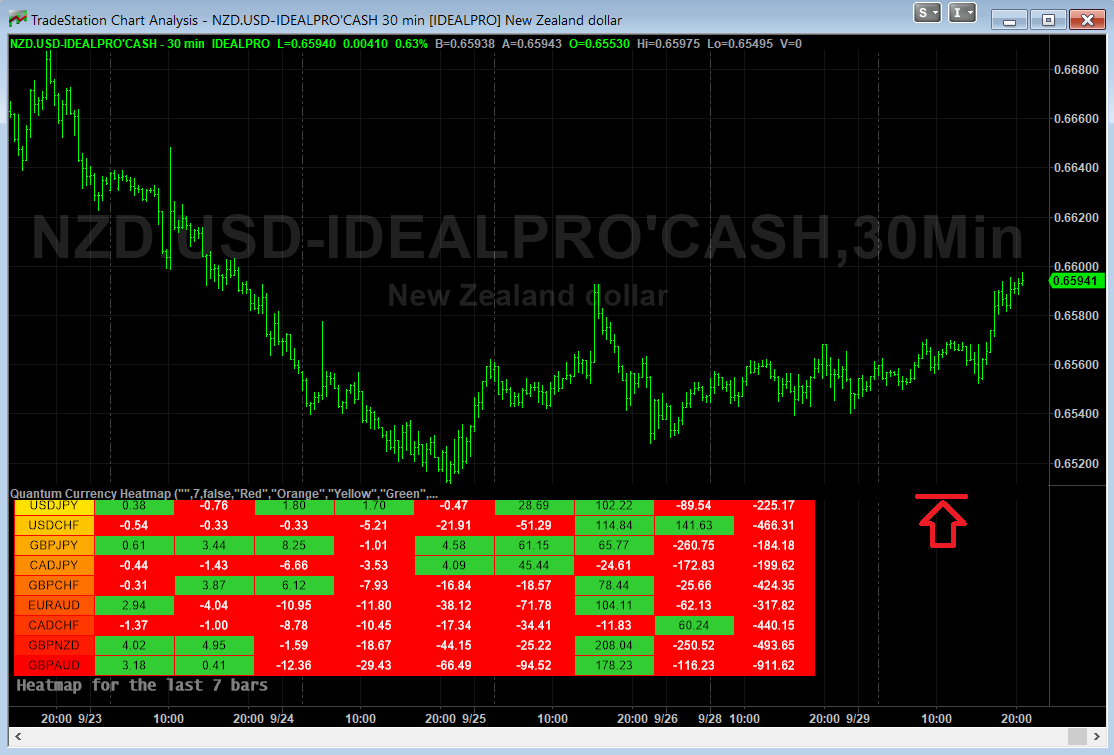
- Hover your mouse pointer over the space between the Quantum Currency Heatmap and the chart above it until the mouse cursor changes into a double headed arrow
- HOLD down the left click on your mouse, and drag the mouse to the top until all currency buttons are visible
- Hover your mouse over the right hand edge of the chart until a double headed arrow appears
- HOLD down the left click on your mouse, and drag the right hand edge of the chart across to the left and release when done
- Click on the chart to make it the active window
- Click on the Increase Bar Spacing icon in the toolbar, to expand your indicator to full size.
Removing the indicator from the Chart Analysis window
From the menu bar of your TradeStation platform, click Format > Analysis Techniques…
In the Analysis Techniques tab, select Quantum Currency Heatmap and click Remove then click Close.
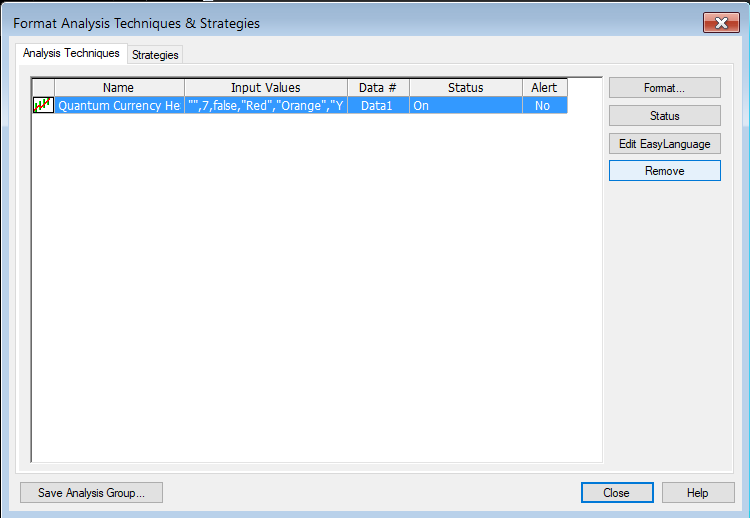
Applying the indicator to RadarScreen
From the Apps menu of your TradeStation platform, please open a RadarScreen window.
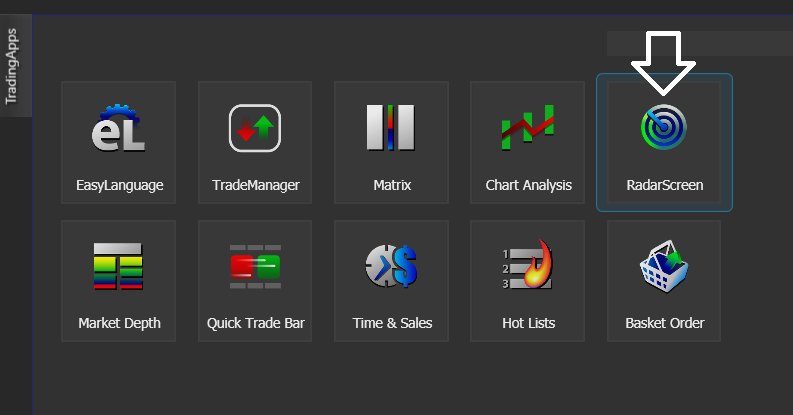
From the menu bar, click Insert > Indicator… > Indicator tab then scroll down at the indicators list at the left hand side and select the Quantum Currency Heatmap. Click the Add -> button to apply the indicator in the RadarScreen. You can change the order of the indicators by clicking the Move up and Move down buttons while the indicator is selected in the list at the right hand side.

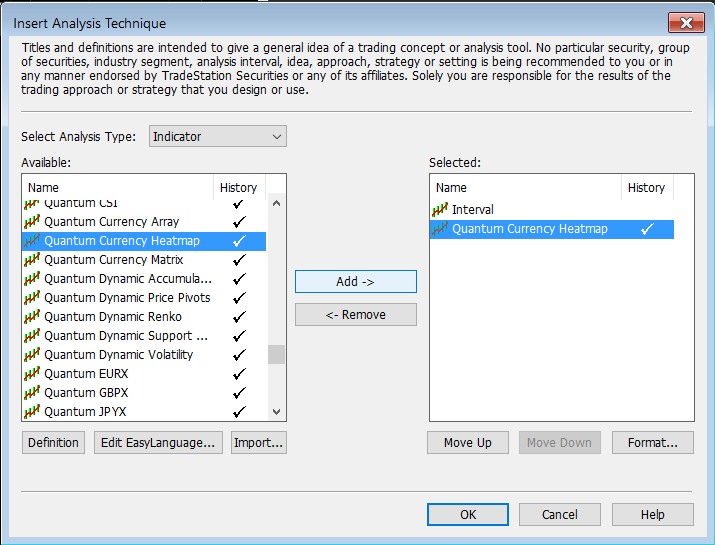
IMPORTANT: If this is your first time to run Quantum Trading indicators, the indicator will not work until you input your email address in its settings. To do this, please go back to your RadarScreen window and right-click the Quantum Currency Heatmap’s column header then select Format ‘Quantum Currency Heatmap’ for all Symbols…
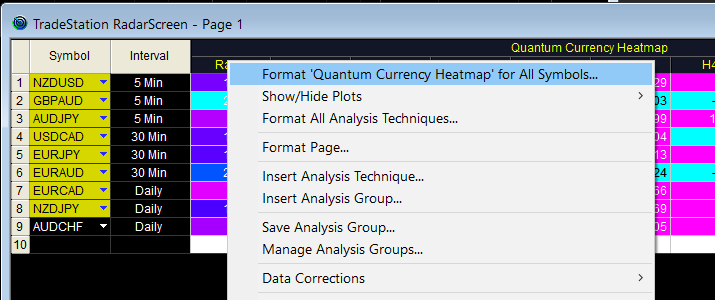
In the Inputs tab, find the MyQuantumTradingEmail input and enter here the email address you used at the Quantum Trading Shop to activate the indicator. PLEASE MAKE SURE TO ENCLOSE THE EMAIL ADDRESS IN DOUBLE QUOTATION MARKS. (example: “myemailaddress@gmail.com”)

Click OK to save and go back to RadarScreen. Please note that you need to do this only once which means you do not need to input your email address again when running Quantum Trading indicators next time.
Compatible symbols in RadarScreen
The indicator works with currency pairs that belong to the combination of the 8 major currencies which are USD, EUR, GBP, CHF, JPY, CAD, AUD and NZD.
RadarScreen columns
Rank
Displays the rank (top to bottom from bullish to bearish) of the currency pair out of the 28 currency pairs in the row’s Interval (timeframe)
M1
Displays the performance score of the currency pair in the 1-minute timeframe within the LookBack period
M5
Displays the performance score of the currency pair in the 5-minute timeframe within the LookBack period
M15
Displays the performance score of the currency pair in the 15-minute timeframe within the LookBack period
M30
Displays the performance score of the currency pair in the 30-minute timeframe within the LookBack period
H1
Displays the performance score of the currency pair in the hourly timeframe within the LookBack period
H4
Displays the performance score of the currency pair in the 4-hour timeframe within the LookBack period
D1
Displays the performance score of the currency pair in the daily timeframe within the LookBack period
W1
Displays the performance score of the currency pair in the weekly timeframe within the LookBack period
MN
Displays the performance score of the currency pair in the monthly timeframe within the LookBack period

Color changes in the RadarScreen
The cell’s background and text color may change on certain conditions.
Cell background color changes
- Green shades (Rank column) – the currency pair is at the top part of the heatmap’s Rank column (bullish)
- Yellow shades (Rank column) the currency pair is at the middle part of the heatmap
- Red shades (Rank column) – the currency pair is at the bottom part of the heatmap’s Rank column (bearish)
- Green (M1-MN columns) – bullish performance within the given period
- Red (M1-MN columns) – bearish performance within the given period
Removing the indicator from RadarScreen
From the RadarScreen window, right-click the Quantum Currency Heatmap’s column header then select Delete.
